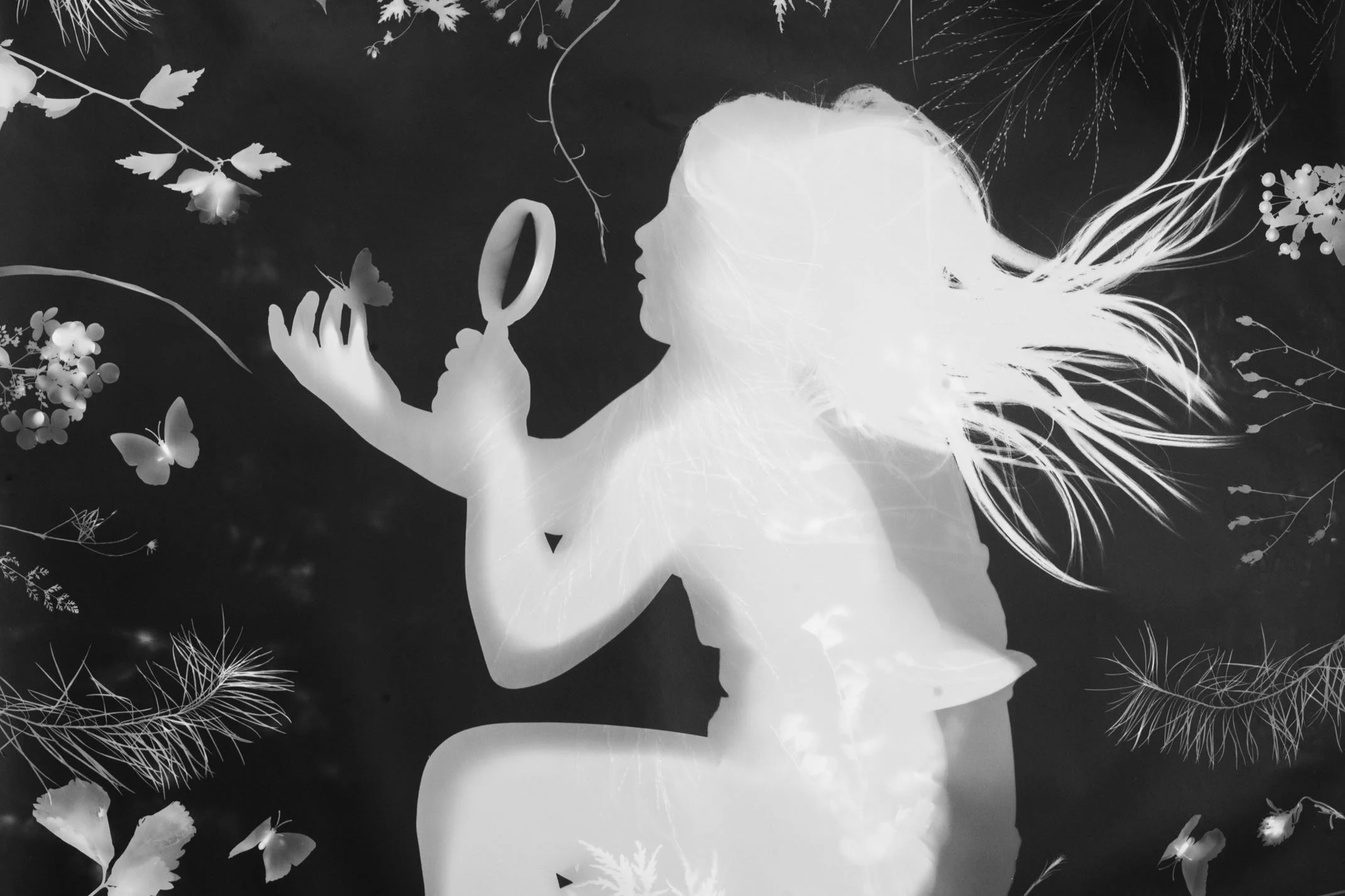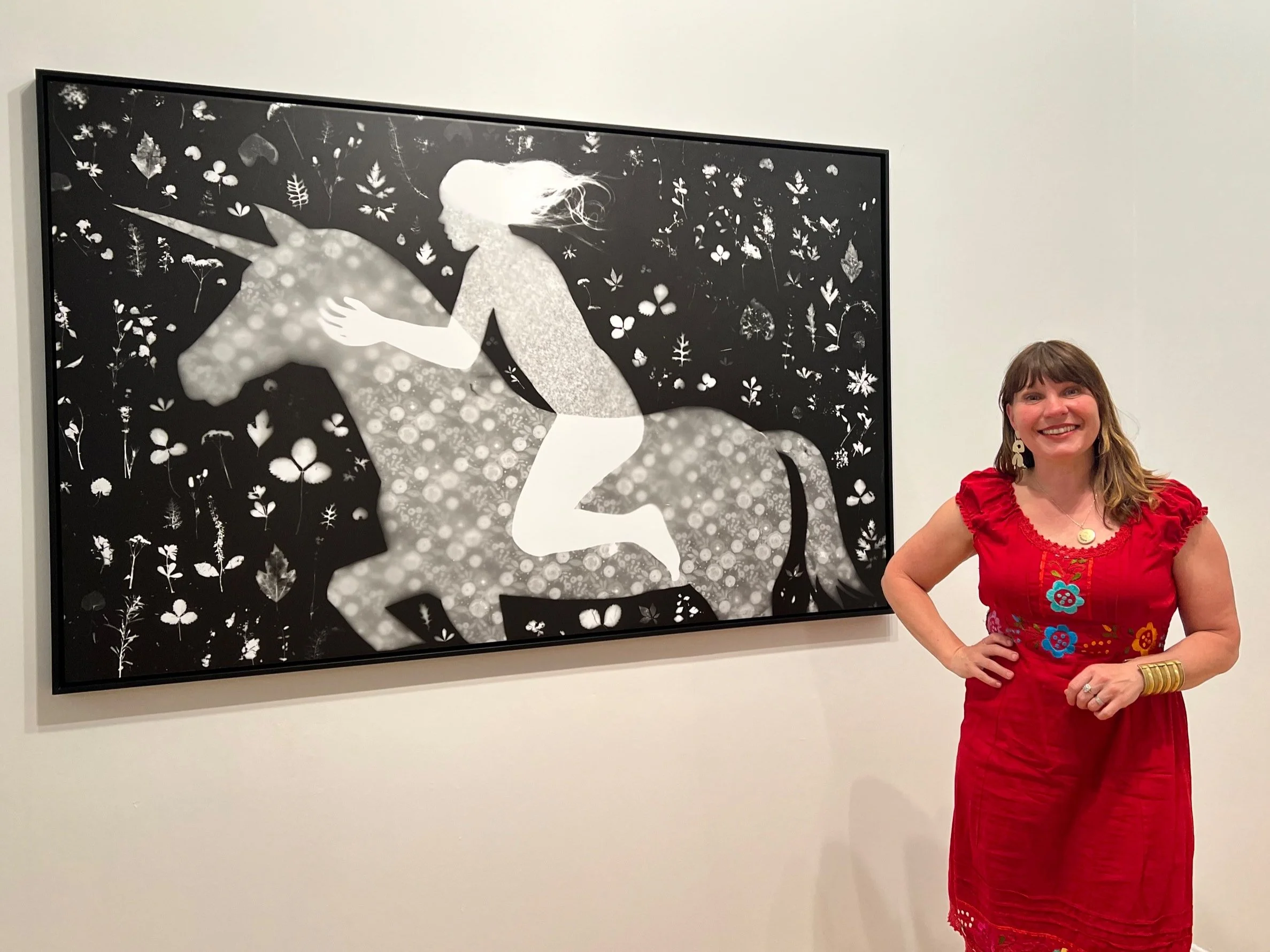The Magic of Light and Shadow in Amy Lovera’s Photograms
A detail from Amy Lovera’s photogram titled Luna. Image courtesy of the artist.
Photo-based artworks have now been in the culture for about two centuries and contemporary society is particularly image-sodden. That can make it challenging to create photo work that does something new or offers viewers a different perspective. For artist and professor Amy Lovera, this challenge is fertile ground for creation. In a recent series of photograms with deeply personal subjects, Lovera shows off her sense for narrative and her inventive artistic mind.
Artist Amy Lovera alongside one of her remarkable photograms. Photo by Michael Rose.
Lovera completed her undergraduate studies at MassArt and earned an MFA at RISD. She’s earned a prestigious Aaron Siskind Fellowship from the Rhode Island State Council on the Arts and her work has been featured in shows at The Griffin Museum, the RISD Museum, and Boston’s Institute of Contemporary Art, among others. On the faculty of Bridgewater State University in Massachusetts since 2017, much of her recent body of work was created during his first sabbatical as a professor. In a recent exhibition in the Anderson Gallery at BSU, Lovera showed off new images that had a remarkable and magical quality.
The artworks that Lovera has created most recently are not photographs, but photograms. There is no camera utilized in the making of these potent and highly contrasted images. Instead, objects and even people are laid down on photosensitive paper which is then exposed to light. The images she achieves with this process are simultaneously bold and sensitive. They also bend expectations and allow viewers a new appreciation for photo-based media.
Asked about her feelings on the process, Lovera is enthusiastic, saying, “So many things about photograms appeal to me! I have never been a photographer who makes images of the world as it unfolds. I am a physical maker of things: my artistic process often involves pre-visualizing my ideas through sketches, building props and sometimes creating costume elements, as well as being a performer in front of the camera. By contrast, editing and printing digital images often feels less tangible and unsatisfying. The process of making these large-scale photograms is very physical and wonderfully unpredictable. I love how this technique reduces photography to its most basic form: I am simply creating images out of light and shadow.”
She continues, “While photography always captures some element of a given moment, I love that these images are literal impressions of my children, at the full scale of their bodies in this specific moment of time. They are also a physical record of our collaboration. I like how the silhouette is both specific to my children but also allows them to be anonymous. The shadow as a metaphor for the intangible and fleeting nature of childhood is also at the forefront of my mind.”
Amy Lovera, Days are Long, photogram. Image courtesy of the artist.
The works are full of a sense of play and experimentation. Although the medium of the photogram can also come across as direct at first glance, Lovera is able to imbue the images with nuance and depth, creating a distinctive world. In her recent exhibition in Bridgewater, the breadth of what Lovera is able to do was on display for the public as well as for her students and the campus community.
Reflecting on how her role as a college instructor informs her practice, Lovera has found it inspirational. She says, “Teaching at BSU has given me access to an analog darkroom after a hiatus of many years. Through teaching analog photography here, I have fallen in love again with the physicality of working in the darkroom and the alchemical transformations that happen there. In fact, the process behind this work was inspired by a project I first gave to my students. Using many small sheets of photographic paper arranged in a grid, I asked my students to use their bodies to make photograms that depicted a mythological scene. This collaborative project was a great ice breaker - with students laughing and problem solving in the darkroom together. The large-scale images they made were exciting to see on the wall and I think the ‘magic’ of the process won over many students to the darkroom.”
Her most recent collection of work is a reflection of Lovera’s constant state of exploration. Although she trained as a photographer, she has tried her hand at many artforms including multimedia work, animation, and performance.
A duo of silhouetted portraits of Lovera’s children, titled Stardust. Image courtesy of the artist.
Lovera is an engaged maker and is already on to her next body of work, which will touch on the multi-faceted roots of her practice. Asked about what is coming next, she says, “I have started exploring shadow puppetry! Last summer, I took part in The New England Puppet Intensive - a marvelous week-long workshop in the possibilities of puppetry. I have started to make a wearable house-shaped screen that will act as a puppet theater for both performing with live shadow puppets and as a surface for projected animation. In the past, I have worked with stop-motion animation and paper puppets. This new work would continue to focus on the themes of childhood I am currently exploring. I'm really excited to make an animation about mud-pies! I am also currently making both large and small scale cyanotypes using the photogram process, which I am hand-painting on. These include the love-letters that my youngest daughter writes to me and other funny notes I find that my kids have written.”
Energetic and imaginative, Amy Lovera is a New England artist to know. In her photograms she explores themes that are simultaneously personal and accessible, charting new paths for the art of light and shadow in the process.
Learn more about Amy Lovera at www.amylovera.com and follow her on Instagram at @amy.lovera.
To receive stories like this one in your inbox each Friday morning, subscribe to the New England Art News Substack.



